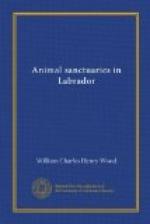The case of the birds is quite as strong, and the chance of protection by this sanctuary much greater. With the exception of the limited egging and shooting for the necessary food of the few residents—the whole district of Mekattina contained only 213 people at the last census—not an egg nor a bird should be touched at all. The birds soon find out where they are well off, and their increase will recruit the whole river and gulf. A few outlying bird sanctuaries should be established in connection with this one, which might be called the Harrington Sanctuary, as Harrington is a well-known telegraph station, a central point between cape Whittle and Mekattina, and it enjoys a name that can be easily pronounced. In the Gulf the Bird rocks and Bonaventure island to the south; one of the Mingan islands, the Perroquets and Egg island to the north; with the Pilgrims, up the River, above the Saguenay and off the South Shore, are the best. The Pilgrims, 700 miles from the Atlantic, are probably the furthest inland point in the world where the eider breeds. They would make an ideal seabird sanctuary. On the Atlantic Labrador there are plenty of suitable islands from which to choose two or three sanctuaries, between Hamilton inlet and Ramah. The east coast of Hudson bay is full of islands from which two corresponding sanctuaries might be selected, one in the neighbourhood of the Portland promontory and the other in the southeast corner of James bay.
There is the further question—affecting all migratory animals, but especially birds—of making international agreements for their protection. There are precedents for this, both in the Old World and in the New. And, so far as the United States are concerned, there should be no great difficulty. True, they have set us some lamentable examples of wanton destruction. But they have also set us some noble examples of conservation. And we have good friends at court, in the members of the New York Zoological, the Audubon and other societies, in Mr. Roosevelt, himself an ardent conserver of wild life, and in Mr. Bryce, who is an ex-president of the Alpine Club and a devoted lover of nature. Immediate steps should be taken to link our own bird sanctuaries with the splendid American chain of them which runs round the Gulf of Mexico and up the Atlantic coast to within easy reach of the boundary line. Corresponding international chains up the Mississippi and along the Pacific would be of immense benefit to all species, and more particularly to those unfortunate ones which are forced to migrate down along the shore and back by the middle of the continent, thus running the deadly gauntlet both by land and sea.




